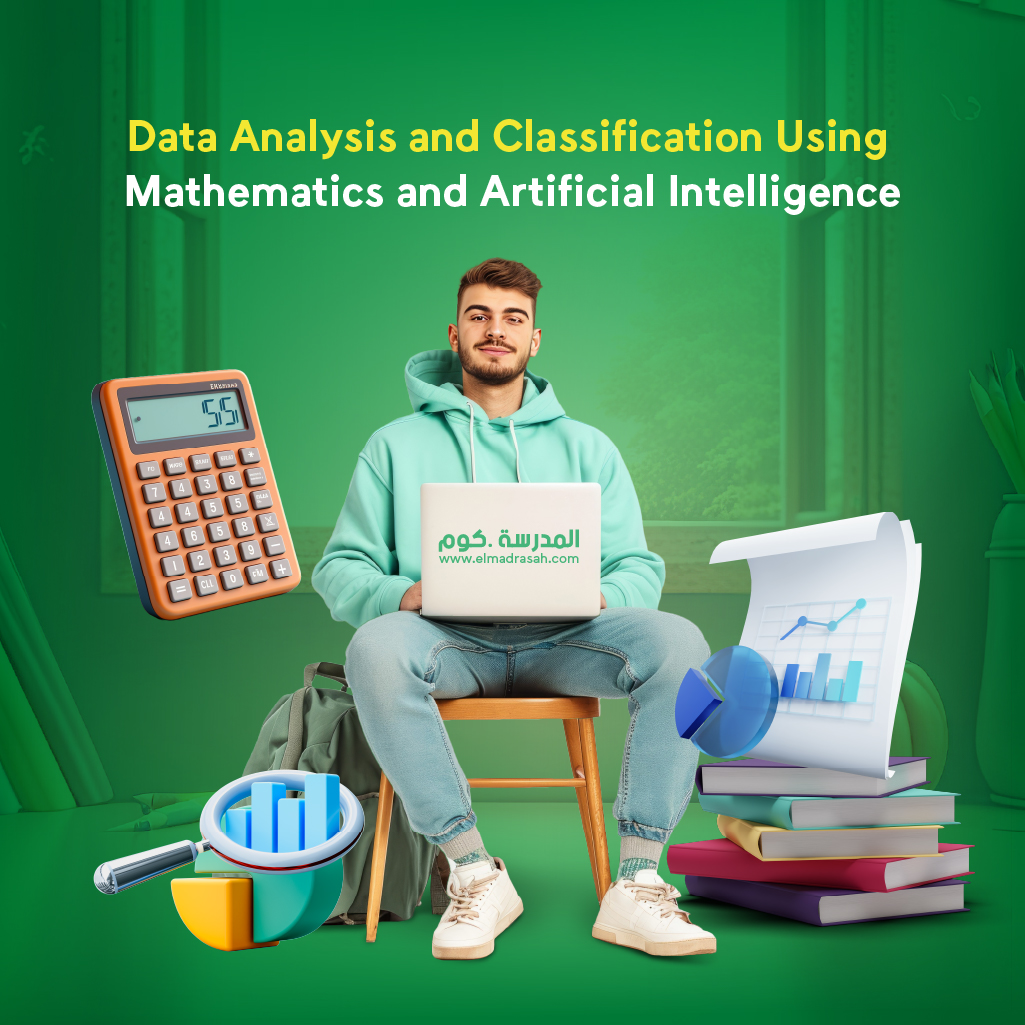

Mathematics and Artificial Intelligence
Mathematics and artificial intelligence are two closely interconnected scientific fields, as each uses tools and concepts from the other to achieve great advances. Mathematics is considered one of the most important tools humans have developed to understand the world around them because it is the language of science and technology and plays a vital role in analyzing and classifying data and solving complex problems. All of this is done through the use of advanced artificial intelligence technologies.
How to analyze and classify data through mathematics and artificial intelligence
There are a set of steps that help clarify how mathematics and artificial intelligence can be used to analyze and classify data effectively, which contributes to the possibility of making the most of the extracted information and making informed decisions.
-
Data collection and cleansing:
The data analysis process begins with collecting data from multiple sources such as databases, the Internet, or sensors. After that, the data is cleaned to eliminate missing or contradictory values and ensure data quality. Techniques such as manual cleaning, replacement with average values, or deletion of incomplete records are used.
-
Descriptive analysis:
Descriptive analysis is used to understand the basic characteristics of data. This includes calculating descriptive statistics such as the mean, median, standard deviation, and range. Charts such as histograms and box plots are also used to visualize the distribution of data and discover initial patterns, all with the help of mathematics and artificial intelligence.
-
Exploratory analysis:
Exploratory analysis helps uncover hidden relationships and patterns in data. Techniques such as correlation analysis and analysis of variance are used to discover links between different variables. Cluster analysis can also be used to group data into similar groups.
-
Predictive Modeling:
Once the data is understood, predictive modeling can be used to develop algorithms that can predict future outcomes. Common predictive modeling techniques include linear regression, logistic regression, and artificial neural networks.
-
Machine learning:
Machine learning is used to build more complex models that can learn from data and make accurate decisions. Machine learning algorithms are divided into two main types: supervised learning and unsupervised learning. In supervised learning, the model is trained using pre-classified data, while in unsupervised learning it depends on the model that detects patterns and structures in unlabeled data.
-
Predictive analysis:
Predictive analysis uses models created to predict future outcomes and common tools for predictive data analysis include techniques such as support vector machines, and deep neural networks.
-
Form validation:
After building the model, its accuracy and efficiency must be verified using a test data set. Techniques such as cross-correction and error analysis can be used to ensure that the model can generalize to new, unseen data.
-
Applying the model and concluding:
Once the model is confirmed, it can be used to analyze new data and draw conclusions. These results can be used to make informed decisions in multiple fields such as marketing, healthcare, finance, and manufacturing.
Group analysis and data classification and its relationship to mathematics and artificial intelligence
Cluster analysis is the process of grouping data into groups or clusters so that the data within each group is similar to each other and different from other groups. This process is used in a variety of applications such as market analysis, biological classification, and customer segmentation. There are several common methods for cluster analysis, including:
K-Means algorithm:
It is used to divide data into groups based on the nearest mean and defines groups based on Euclidean distances between points and medians.
Hierarchical algorithms:
A hierarchical tree is built from data that is repeatedly merged or split, allowing users to choose the appropriate level of detail.
Principal component analysis:
It is used to reduce the dimensionality of data while preserving as much of the original variance as possible, which facilitates classification.
Data classification
Data classification is the process of organizing data into specific categories based on certain characteristics. Classification is used in a wide range of applications such as email classification, disease prediction, and image recognition. Common algorithms for data classification include:
Decision tree:
They are used to make decisions based on a set of conditions and rules.
Support vector machine:
It is used to separate data into different categories by finding the best-dividing line or space.
Neural networks:
It is used to build models capable of learning from and adapting to data to improve classification accuracy.
Relationship with mathematics:
Mathematics is the foundation on which all group analysis and data classification techniques are built. For example:
Linear algebra:
It is used in principal component analysis and in neural networks, where operations on matrices are fundamental.
Statistics and probability:
It is used to evaluate the performance of models and in methods such as the K-Means algorithm and analysis of variance.
Calculus:
It is used in training neural networks, where optimization techniques are used to minimize the cost function.
Relationship with artificial intelligence:
Group analysis and data classification are an essential part of artificial intelligence and machine learning techniques. Artificial intelligence uses these techniques to understand data, discover patterns, and make smart decisions. Examples of this are:
Products Recommendation:
It uses clustering analysis techniques to group users based on their preferences and recommend appropriate products to them.
Image recognition:
It uses data classification techniques to recognize and classify objects in images.
Disease prediction:
It uses classification techniques to predict the likelihood of a person contracting a particular disease based on his health data.
To summarize the above, it can be said that cluster analysis and data classification are two vital parts of the fields of mathematics and artificial intelligence. Thanks to advanced mathematical techniques and artificial intelligence algorithms, we can understand data more deeply and make more accurate and efficient decisions.
The role of mathematics in detecting cyber attacks
After learning about the relationship between data analysis and classification with mathematics and artificial intelligence, the time has come to find out how mathematics can be used in various fields of artificial intelligence. Mathematics plays a vital role in cybersecurity, especially in detecting and preventing cyber-attacks. Techniques for detecting cyber attacks depend on a variety of Mathematical tools and models to help in analyzing data, identifying anomalous patterns, and predicting future threats, so through the following, we will explain how to use mathematics in detecting these attacks.
Big data analysis:
Cyber attacks are often hidden within huge amounts of data and big data analysis techniques rely on mathematical algorithms to analyze and filter data quickly and efficiently. Through the use of techniques such as linear algebra and statistics, anomalous patterns that may indicate malicious activity can be identified.
Anomaly detection:
Anomaly detection is one of the most important techniques for detecting cyber attacks. This technique relies on statistical models and machine learning algorithms to determine the natural patterns of behavior in the system. Any deviation from these patterns could indicate a cyber attack, which uses methods such as:
- Regression analysis: To predict future values based on historical data and identify anomalies.
- Probabilistic models: To evaluate the probability of certain events occurring and identify abnormal patterns.
Encryption:
Cryptography is another area in which the importance of mathematics in cybersecurity is evident. Encryption relies on complex mathematical concepts such as number theory and algebra to protect data and ensure its confidentiality. Encryption technologies such as RSA and AES also rely on mathematical algorithms to ensure that data can only be decrypted by authorized persons.
Machine learning:
Machine learning is increasingly being used to detect cyber attacks. Machine learning models rely on mathematics to build algorithms capable of learning from data and adapting to new threats. Some methods include:
- Artificial neural networks: are used to analyze complex patterns in data and predict attacks.
- Principal components analysis: To reduce the dimensionality of data and detect anomalous patterns more effectively.
Chart analysis:
Cyber attacks are often linked events, and graph analysis helps understand the relationships between these events. Using graph theory, cyber networks can be represented as graphs and analyzed to detect patterns that indicate attacks.
Statistical models and Bayesian analysis:
Statistical models estimate the probability of a cyberattack based on historical data and current behavior, and Bayesian analysis helps continually update these estimates based on new evidence.
Mathematics is the backbone of cyber attack detection techniques. Through the use of mathematical and statistical models, systems can recognize anomalous patterns, predict future attacks, and effectively protect data. Mathematics is also a powerful tool that helps improve cybersecurity and strengthen defenses against increasing threats in the digital age.
Game theory and artificial intelligence
Game theory is a branch of mathematics that deals with the study of optimal strategies in situations of conflict and cooperation between different parties. The theory is used to analyze and determine the optimal behavior of players (parties) in games (situations) that include gains and losses. Game theory is also used in a wide range of fields such as economics, politics, and sociology, but it has also become an essential tool in artificial intelligence.
This theory contributes to clarifying the strong relationship between mathematics and artificial intelligence. Game theory provides a strong mathematical framework for analyzing and developing artificial intelligence strategies in conflict and cooperation situations. By applying this theory, it is possible to develop intelligent systems capable of interacting effectively and efficiently, which opens new horizons for improving performance in a lot of practical applications.
The role of game theory in artificial intelligence:
Game theory is used in artificial intelligence to develop intelligent strategies in situations of conflict and cooperation. This theory plays a vital role in designing intelligent systems that can interact with each other in complex ways. There are several ways in which game theory is applied in artificial intelligence:
Multi-Agent Reinforcement Learning:
In multi-agent artificial intelligence systems, many independent agents interact in a shared environment, and game theory is used to analyze and develop strategies that enable these agents to achieve their individual and collective goals. Multi-agent reinforcement learning enables agents to learn through experience and adapt to the strategies of other agents to achieve balance. This method greatly illustrates the relationship between mathematics and artificial intelligence.
Cooperative games:
This method also contributes to clarifying the relationship between mathematics and artificial intelligence. In some cases, agents need to cooperate to achieve a common goal, and cooperative game theory is used to analyze how gains are distributed among cooperating agents fairly and efficiently. Techniques such as shell partitioning are also used to ensure that gains are distributed fairly between agents based on their contributions.
Non-cooperative games:
In situations where agents compete to achieve conflicting goals, non-cooperative game theory is used to develop strategies that enable agents to make optimal decisions, and concepts such as Nash equilibrium are used to identify points at which each agent is unable to improve its situation without changing strategies.
How does the elmadrasah.com platform contribute to encouraging the use of mathematics and artificial intelligence?
Elmadrasah.com platform contributes significantly to encouraging the use of mathematics and artificial intelligence through a set of strategies and initiatives, through the following, we will explain some of how the platform can achieve this.
Providing specialized educational courses:
- Providing comprehensive courses covering various fields of mathematics, such as algebra, geometry, calculus, and statistics. These courses can also include interactive materials, educational videos, and applied exercises.
- Providing educational courses that cover the basics of artificial intelligence, machine learning, deep learning, and big data processing. These courses may include practical examples and applied projects.
Organizing workshops and seminars:
- The platform is interested in organizing workshops focusing on the use of mathematics in artificial intelligence, where students can learn how to apply mathematical concepts in developing machine learning models.
- The platform organizes webinars with experts in mathematics and artificial intelligence to discuss the latest developments and research in these fields.
Providing technical and community support:
- The platform has created discussion forums where students and teachers can exchange ideas and tips on using mathematics and artificial intelligence.
- The platform is interested in providing technical support to students who face difficulties in understanding materials or implementing projects, including individual consultations or support via email.
Focus on real applications:
- The platform encourages students to apply mathematics and artificial intelligence concepts in community projects that help solve real problems such as improving health services or developing solutions to environmental challenges.
- The platform is also interested in presenting case studies that illustrate how mathematics and artificial intelligence are used in different industries, which inspires students and opens their eyes to the practical possibilities of these fields.
Elmadrasah.com platform plays an important role in promoting the use of mathematics and artificial intelligence through the best educational methods and resources that can benefit the largest possible number of students of all ages. This made the platform inspire students and provide them with the necessary skills to excel in these vital fields.
In conclusion, it can be said that mathematics and artificial intelligence constitute a powerful duo that opens wide horizons of innovation and progress in various fields. Mathematics can transform abstract ideas into accurate and analyzable models and work to form the basis on which artificial intelligence techniques are built, through advanced mathematical theories and complex algorithms. Artificial intelligence can analyze huge amounts of data, recognize patterns, and make informed decisions. By using the educational resources provided by elmadrasah.com, you can ensure excellence and distinction in this field.















